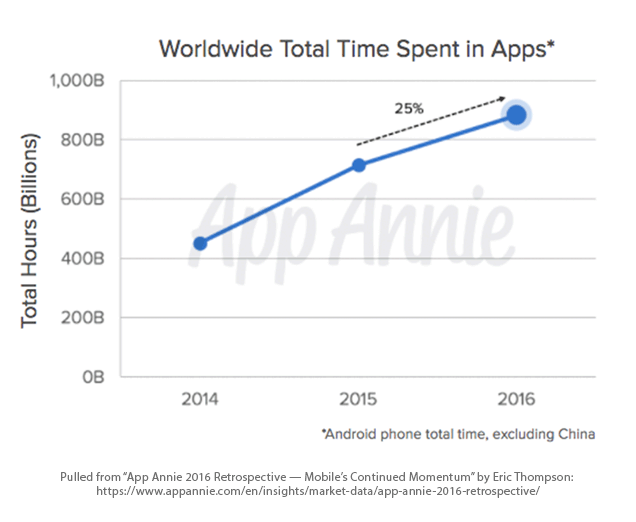3 Types of Alternative Black Friday Campaigns
Calling Black Friday the biggest shopping event of the year is an understatement. In 2019, consumers spent $7.4 Billion online alone. This year more than ever, online spending is expected to grow. What are some ways to stand out online this holiday season?
Instead of the usual ‘one-day-only % off’ sale, campaigns focused on other things can be a great way to set you brand apart, gain awareness, and increase conversions. Here are three examples.
#1 – the Anti-Black Friday.
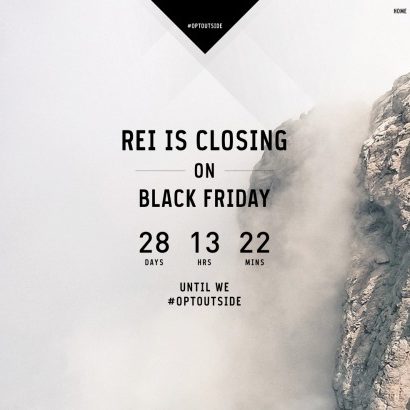
Taking a page from REI’s #OptOutside campaign, focusing on not buying anything on Black Friday can be very effective. Since 2015 REI closes on Black Friday and uses #OptOutside to encourage people to spend the day outside, which goes along perfectly with their brand mission and has helped grow their online community. Due to the longevity of the campaign and community it has created, the Opt Outside campaign helps increase REI sales year-round.
Another company using the Anti-Black Friday approach is the skincare company Deciem. In 2019, closed their stores and blacked out their website to protest the hyper consumerism focused Black Friday. Instead, their holiday campaign focused on “shopping slow.” For the entire month of November, every product was on sale. The longer, inclusive sale increased sales and helped reinforce their brand ideals with their customers.
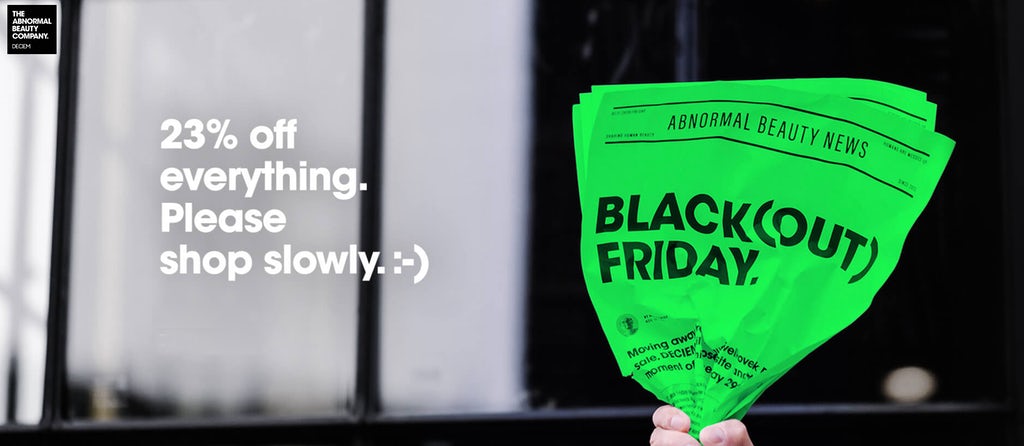
#2 Highlight Your Mission
Many companies use Black Friday as an opportunity to show their customers what their brand ideals are. Donating to charities is a popular way. For example, Patagonia is known for alternative Black Friday campaigns but one especially effective one was 2016. They pledged to donate all their Black Friday sales to grassroot organizations that aligned with their brand goals. The campaign ended up generating $10 million in sales, over 5xs their goal!

The fashion company Kotn did something similar. Instead of sales, they promoted that they were going to donate Black Friday weekend profits to a charity that builds schools in Egypt, where the cotton used in their products is grown.
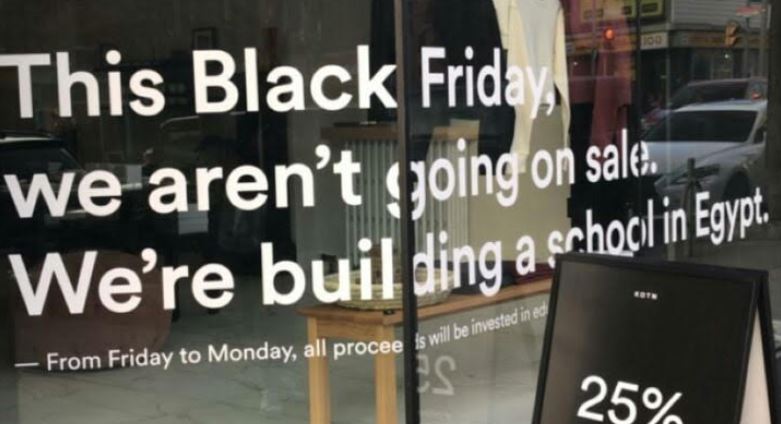
#3 Make it an event
A great example of this is MeUndies’ 2016 campaign. They promoted a Facebook live event for Black Friday. As more people joined, they unlocked more discounts and promotions. The event ended up with over 13,000 viewers and had a conversion rate of over 25%, which is 13x more than their average!
All of these brands used a day usually clogged with advertising to redirect their customer’s focus. They reminded people of their band mission and goals and helped strength their connection to their customers. What fun ways have you seen company handle Black Friday?
How Can Data Help Multichannel Marketing?

Quality data and the proper interpretation is the foundation for any campaign. Especially for campaigns using more than one more channel or multichannel marketing. Customers now want personalized messages and interaction in the channel of their choice. The only way to do that successfully is have ongoing campaigns, spread out of many channels. How can data help?
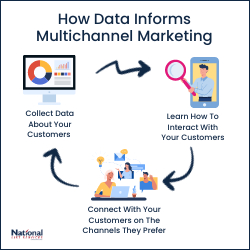
Step one for any campaign is to know your customer. Dig through all your first party customer data to create personas of your target customers. Knowing about your customers will help you figure out what channel they will mostly like to engage through.
It is helpful to give your customers and potentials multiple touch point options. Encourage your customer to sign up for emails, interact on social media, and any other engagement options. The more data you have on your customers, such as email, phone, social accounts, and their address the easier it will be to engage in a way that reaches them.
Next, you can collect data and analytics about your customers from the channels you are using to constantly to learn more about your demographics and your customer’s buying habits. The more channels you use the easier it will be to learn about your customer.
Knowing what channels your customers prefer can save you money. For example, there’s no point in sending your target audience direct mail if you know that’s not a channel that works for them. Therefore, collecting data about your customers can help you lower your CPA and give your faster ROIs.
How are you using data to inform your multichannel campaigns?
Want to learn more about how customer data can help your business grow?
What’s Working in Marketing- 2020?

Eleven months into 2020, it is safe to say, this year has had a lot of surprises. So, what has working in marketing this year? Here is what we have found:
1) Customer Experience driven marketing. This encompasses a lot of things. The main things that we have found to be successful in 2020 are brand storytelling and personalization.

Our brain is literally wired to seek out and respond to narratives. And no matter what is happening around us, that isn’t going to change. We are going to connect and respond better to brands that tell us a story and bring us along on a journey. How are some companies implementing this strategy? YouTube series, podcasts, active social medias are popular first steps. (Learn more about customer journey’s here.)
Personalization is a big key in reaching your customer’s heart. Using the customer’s name in things like email subject lines is a good first step. Beyond that you can use audience segmentation to separate your audience into groups that share common characteristics like demographics and behavioral information. Using your audience segments to target your message to things that each group are actually invested in can greatly increase how personal your marketing will feel to the customer.
Utilizing Multi and Omni channel marketing strategies will also increase how smooth your brand experience is for your customers. (Learn more about building audiences here and here.)
2) Email. More than 50% of people in the US check their personal email over 10 times a day. Most people say that it is their preferred way to communicate with brands. Although “the end of email” has been threatened may times in recent years, 2020 has shown us that email isn’t going anywhere soon. For many companies, email became the only way they could communicate with their customers this year.
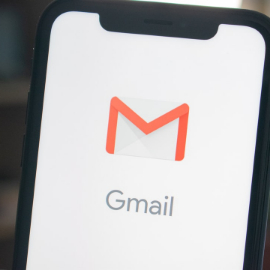
That means the margin for error with sending emails is relatively small. So. don’t forget to preview your email with different providers and devise before your send!
(Here are more email tips and tricks.)
3) Responsible consumerism and business practices. More than ever, consumers are aware of the effect their purchases have on the environment and on society and they want to buy from companies whose values align with theirs. People expect companies to actively fight injustices and be visibility support causes.
What has worked for your marketing this year?
What’s Your Customer Journey?

In 2020 we have lost many personal or face to face connections with customers. Therefore, digital marketing has to feel more personal. How? Focusing on your customer’s journey is the first step.
What is a customer journey? The customer journey is the order of all of your customers interactions and experiences with your company and brand. It is often illustrated in map form.
How can you build a customer journey?
Step one, who are your current customers? Analyze your first party data. What does your average customer “look” like? What is their age, gender, occupation? Do they have any specific interests or hobbies?
Step two, who are your potentials? Once you know who your average customer is you can build a look-a-like report to gain more prospects. (What is a look-a-like report? Get more information here.)
Step three, map their journey. How do they first hear about your brand? What are going to be their first interactions? What happens before they buy something? What happens after?
Here’s how that could be illustrated:
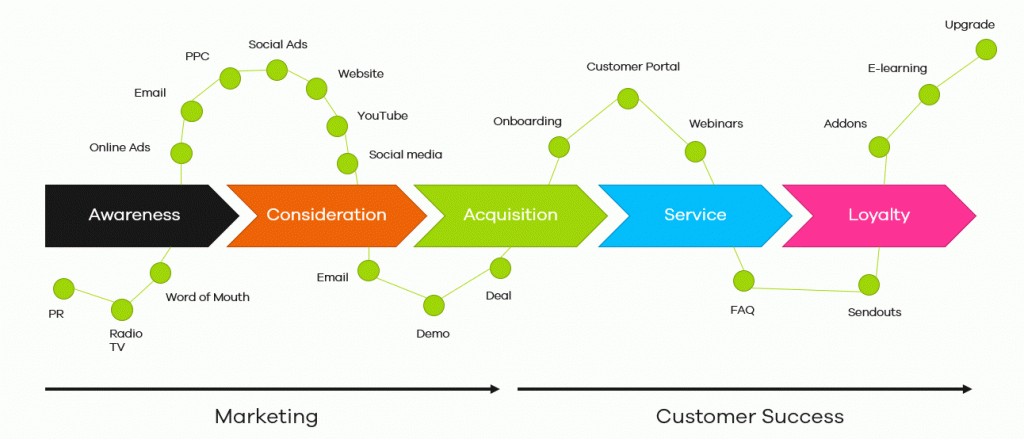
Blast marketing campaigns aren’t nearly as effective as they used to be. Building a campaign based on your customer’s journey can greatly increase your conversions and long-time customer loyalty. (One study found conversions were boosted over 300%!)
How can you use customer journeys?
6 Tips for Effective Content Marketing

According to HubSpot, nearly 70% of business are investing in upping their content production this year. What can you do to make sure your content stands out from the rest?
Here are six steps:
- Figure out what you want to accomplish. Goals are key to any plan. The Content Marketing Institute (CMI) suggests outlining your goals in a formal business plan. It will also be helpful to outline what value you are going to provide your customers with your content and any possible challenges.
- Figure out your audience. Knowing who you want to reach makes it much easier to know what type of content they’ll want to engage with.
- Remember your own branding. What do you want your customers to know about you? What problems can you solve for them? How are you different from your competitors? Knowing what your overarching message will help you choose the right type content and tone.
- Figure out what type of content your audience will respond to. There are so many different types of content, such as blog posts, eBooks, videos, podcasts, webinars, newsletters, etc. However, not all of them will be effective for your audience.
- Keep a schedule. You’ll need a clear plan of attack, especially if different parts of your organization will be involved in content. HubSpot recommends implementing an editorial and a social media calendar. To keep tract of when are where content is going out. Doing so will also help keep your messaging cohesive.
- Keep track of engagement. Keeping track of analytics will help you learn your content’s effectiveness. You can use what you’ve learned about what works or your audience to inform upcoming decisions and make your content continually more effective.
Want more information on how to make your content marketing more effective? Get in touch here.
How To Digital Advertise Effectively

With things changing around us so quickly, having a long-term advertising strategy can be a challenge. We need real time audience data as much as possible. How can we build an adaptable audience in this rapidly changing world?
One of the biggest changes in advertising this year was the extreme shift to digital. In an eMarketer poll, 56% of people said that they increased their online shopping this year. And 14% said that they shopped online for the first time. The way we shop has also changed. Because of the increase in online shopping, we tend to make faster, more impulsive purchase decisions. What does that mean for advertising?
Before the necessary shift to digital, brands could interact with customers in a wide variety of ways, often spread out over large physical distances. Billboards, signs, posters, newspapers, and magazines all exist with in different physical spaces. With digital advertising however, we are all competing for the same ad space. That ad space is worth more now has less guarantees attached to it.
Having the right audience is the foundation for your campaign…..
Asking yourself simple questions about your clientele such are gender, age, income, and possible other interests can make it easier to target more efficiently.

What can you do then make sure your potentials are seeing your brand? Start with the right people. A lot of marketers view the audience as a small detail or a piece of the puzzle. Having the right audience is the foundation for your campaign. Asking yourself simple questions about your clientele such are gender, age, income, and possible other interests can make it easier to target more efficiently.
Having a general idea of your audience is a good first step. Slowing narrowing down that audience helps reduce costs. A trigger-based campaign is a good way to do that. For example, you can send an email to a large amount of people who fit your initial criteria rather cheaply. Since social ads are more expensive, you then only need to advertise to the people for clicked or opened your email. You can then retarget them with Direct mail. Learn about your audience from each channel individually then apply it back to your campaign as a whole.
As difficult as it can be to have to shift an entire advertising strategy, it can be also be a great opportunity for growth. Using different channels can help you take a step back and look at your campaigns and your potentials in a new light. What have you learned about adapting strategies this year?
Save 80% Time & Money: How to Market to the Crucial 20%
 Wouldn’t we all like to save 80% of our time, money and marketing effort, while getting 10 times or even 100 times the results?
Wouldn’t we all like to save 80% of our time, money and marketing effort, while getting 10 times or even 100 times the results?
However, that’s just what Cara accomplished. Let’s see how she did it, and how easily you can do the same.
Starting out, Cara did what most failing marketers do… she found a “deal” renting a cheap list of 5000 prospects for 20 cents per name. It cost her an extra dollar per person to get the offer in front of her list. Total cost: $5500. Since 40 people bought her product at $100 profit each, she got $4000 back for her effort.
Poor Cara. She lost $1500 on this campaign. (Okay, I rounded the numbers, but this is really close to what happened.) Sadly, she thought her target audience should be “everyone interested in my product.” But the school of hard knocks really motivated her to take a closer look at buyer personas and exactly who her ideal audience is.
“What things do I need to look at to find my ideal customers?” Excellent question, Cara.
Fortunately, she found a great data provider who guided her through modelling tools and buyer propensities. Cara selected a list of only 500 prospects. Sure, these extra data analytics cost $2 per name instead of 20 cents each. Was it worth it?
Well, considering she spent the same dollar per person to get her offer in front of the new list, her total cost was $1500. This time, she sold to 30 people, making sales totaling $3000. Yay for Cara! This time, instead of losing, she doubled her money.
Really though, she saved 73% of her marketing cost. And she converted 7.5 times as many prospects into sales. But, you may say, how could you get 100 times the results? Another great question.
We’ve all heard of Mr. Pareto. The original 80/20 guy. Truth is, his principle can be applied to itself. Not only will 20% of your best prospects give you 80% of your profits… The top 4% of your prospects will give you 64% of your profits. (20% of 20% and 80% of 80%.)
Wow.
So, if you can identify the top 20% of your best prospects, you can really be 16 times more profitable. And if you identify the top 4% of your prospects…wait for it…you can be 250 times more profitable . If you are not following this formula, “you are leaving millions on the table,” says Brian Kurtz, Executive Vice President of Boardroom Inc. and leading direct marketing expert.
Don’t think it’s that valuable to niche down this much? Look at Amazon. They specialize in one tiny niche after another. And even a decade ago, that’s how they sold 50% of their books. Even small businesses can compete with large companies by targeting a smaller niche like this.
How can you make this easy for your business?
 Let’s say you’re the Dallas Cowboys. Most fans will get into the stadium for $19. Some of them will get $1000 season tickets for the mediocre seats. Only a few will get the $10,000 seats near the 50-yard line. And a tiny fraction of them will dish out far more money than this to enjoy the ultra-exclusive sky boxes. How much will a raving football fanatic (with money) spend on football? A virtually unlimited amount. You want to find THIS kind of people. And you CAN (and should) find them.
Let’s say you’re the Dallas Cowboys. Most fans will get into the stadium for $19. Some of them will get $1000 season tickets for the mediocre seats. Only a few will get the $10,000 seats near the 50-yard line. And a tiny fraction of them will dish out far more money than this to enjoy the ultra-exclusive sky boxes. How much will a raving football fanatic (with money) spend on football? A virtually unlimited amount. You want to find THIS kind of people. And you CAN (and should) find them.
Even if you’re only the company selling the peanuts.
Ask yourself about demographics: Who are your best customers? How old are they? Where do they live? What about their gender, income level, education, family/marital status, occupation and ethnic background? Now, ask yourself about their motives. What makes them buy? What is their personality, attitudes, values, interests/hobbies, lifestyle and behavior?
How can you know this stuff?
It’s not as hard as you might think to learn the right way to use a propensity modelling tool. Or some brand new (and yet relatively inexpensive) methods to give you real behavior data on your ideal customers.
Stay tuned.
Or better yet, call us. We’re happy to walk you through our tools right now.
| Click here to learn more |
Why Is It So Hard to Get a Good Marketing ROI?

Michael stood in front of the screen – palms sweaty and dreading the result – only to stare in shock at the number in the email. Just two measly sales… after all the cash he’d poured into this one marketing effort.
“How could I be so wrong? Will anyone trust me again?” If you’ve ever felt the anxiety bleeding through your team after a campaign like this, you’re not alone.
And fortunately, this nationwide homebuilder learned the big reason why they (and so many others) flounder so miserably with their marketing.
Knowing your audience is the key.
It seems this simple idea is pounded into us from every angle.
Companies “think” they understand.
They listen to the experts and read the articles. Yet when they send out offers to people, it’s obvious they really don’t know their audience. We hear about lookalike audiences, buyer personas and modeled propensities. It’s a great idea: reach your best prospects – the ones most like your best existing customers. And if it’s done right…
Michael decided on a short consultation and to try our data. He was a little cautious though, probably even a bit skeptical. “Let’s aim for 4 sales.”
When he got 12 sales and made $13.64 on every dollar he spent, Michael became a believer.
Knowing your audience is just this powerful.
And without a doubt, it’s the first step to make your marketing efforts effective in 2018.
How does it work? You start by sending a spreadsheet or list of your current customers. Maybe all you have is just their names and addresses. Likely there’s quite a bit of information on your customers. (In the sample below, we found data on 85% of our client’s customers.)
Sure, quite a few data companies could tell you the marital status, number of kids and simple demographics on your customers. But what about their political preference? Their hobbies? The way they connect to the internet? Their health, income, vehicles, even how they use their credit cards? (Obviously, due to privacy we can’t learn some of these things directly.)
If you analyze dozens of factors like these – with your best customers – you’ll start to see amazing trends. You can even see why they buy, and when. More than this, what if you could search through 250 million people, using these same factors?
You could find a CROWD of people with the SAME motives and timing.
Imagine what this can do for your sales and profits.
In the sample report below, notice these prospects are labeled “Best performers.” And there are 1.3 million of them.

Focus your best marketing efforts on these people.
And of course, this number could be narrowed down even further – even more targeted. For example, by using pre-defined propensity models, you can learn even more about people and how likely they are to behave like your existing customers.
Want to reach more people? No problem. There are 9.4 million “Undecided prospects.” People where some of the factors match, but they are less likely to buy than the “Best” ones. You could target them with a different kind of offer.
This is what an augmented lookalike report can do for you.
How do you feel about this? How do you get to know your audience? Want to get to know your audience like this?
Pick up the phone and call us.
We’re going to help some select companies exceed their marketing goals in 2018. Are you in?
| Click here to learn more |
The Shocking Truth About Your Marketing Channel
 Many people still believe you only need one marketing channel – and they couldn’t be more wrong. For example, malls are lined with countless businesses. And most of these shops rely solely on one thing: a crowded mall area to bring people inside to buy.
Many people still believe you only need one marketing channel – and they couldn’t be more wrong. For example, malls are lined with countless businesses. And most of these shops rely solely on one thing: a crowded mall area to bring people inside to buy.
Analyst Jan Kniffen says one-third of all the big malls in America will close their doors over the next few years. Nearly two-thirds of the remaining malls will struggle.
Industry veteran John Hazen asked his peers at a recent conference: “Is anyone not seeing large traffic declines?”
Why Single Channel Marketing Is Killing You
Consider this scenario: Brandon McDonald, of Nashville, Tennessee, walks into a local store. Brandon is excited about the Nikon digital camera he’s planning to buy and have in his hands today. Yet when he gets into the store, he decides to scan and check the price with an app on his phone. An online company is selling the same camera for less than what the store is now offering. Brandon decides to buy online and wait for his camera to arrive.
Why Selling Online Doesn’t Fix This Problem Either
Remember, Brandon first wanted to buy from the local store. Like so many customers, he loves to hold the camera in his hands–instant gratification. If only the store knew what Brandon wanted. It would have been win-win for Brandon and the store.
This problem doesn’t just plague retail stores and physical products.
The Secret To One Bank’s Success
One regional bank depended almost entirely on people walking into the bank and asking for a loan.
Yes, they have a website. But only about 1% of web visitors were submitting a loan request. The bank decided to look at data for their mobile and online visitors–surprise! They could recover the business of a significant number of people who abandoned the bank’s online loan form. Sales of current-account and personal loan products shot up 25%.
This is just one way that mobile insights are changing the face of marketing. And moving the whole world toward multi- and omnichannel marketing.
![]() Your Customers Expect Multi & Omnichannel Marketing
Your Customers Expect Multi & Omnichannel Marketing
As you can see, marketing to people through multiple channels or methods increases your ability to sell and profit. Omnichannel marketing means tying these methods or channels (apps, digital tools or shopping venues) together in an easy-to-use, consistent way for even more profit. More and more, customers are expecting this kind of buying experience. They want to hop on their phone or device and see exactly what inventory you have available. Or they want to shop online and pick products up at your local store.
The Numbers Don’t Lie
Rice University studied 46,000 shoppers for a 14-month period.
Only 7% shopped online exclusively. And 20% visited stores without using any other apps or venues. A whopping 73% used multiple channels in their shopping journey. These multi/omnichannel shoppers absolutely love touchpoints – in all sorts of combinations and locations. Touchpoints like offers to compare prices and download coupons.
In fact, they are avid users of all sorts of mobile tools such as interactive catalogs and price checkers. They bought online and picked up at the store. They bought at the store and got their products shipped.
Multi-channel and Omnichannel Shoppers Are More Valuable
And those who used multiple channels spent 4% more in the store and 10% more online than the single-channel folks. In fact, those who used 4 or more channels spent 9% more in-store than the one-channel shoppers. And those who used apps to research online first? They spent 13% more in-store. Six months after these shoppers had their first omnichannel experience, they were shopping 23% more. And they were far more likely to recommend their chosen brand to friends and family.
The “Killer App”
No wonder many are calling omnichannel marketing the “killer app” – because it’s saving the future of so many businesses. Despite the bleak future of single-channel businesses, you now know the secret that empowers you to reach your customers at the right time, with the right message. It’s why the most successful marketing campaigns today are omnichannel campaigns. It’s how you give your customers what they really want.
How will you use omnichannel marketing?
Contact us to learn more about how multi-channel & omnichannel marketing can improve your prospect marketing.
| Click here to learn more |
The Power of Mobile Data in a Data-Centric World

Modern marketing is fully embracing the explosive emergence of mobile-based consumer data. Because of its ability to capture a more accurate snapshot of when consumers are seeking out a particular company–or its products and services–mobile data has created a step-change in how marketers are crafting and delivering their message. Consumers are seeing this change manifest itself into today’s highest performing omnichannel strategies; which is connecting them with the right message, through the right channel, and most critically… at the right time.
It’s estimated that by 2020 more than 80 percent of adults worldwide will have mobile devices. This is going to continue to drive up social media usage, increased families with multiple devices, and even more data for marketers to utilize to better connect with consumers. Smartphones and tablets have given consumers real strength in terms of providing them with multiple platforms to access businesses, for finding information on products and services, and to even purchase those items.
What Do the Numbers Say?
How much data the world currently uses is creeping up, rising from 7 exabytes per month in 2016 to 11 exabytes per month in 2017, with a predicted increase to 17 exabytes per month in 2018 (one exabyte is one quintillion bytes). However, that number could increase exponentially to 49 exabytes per month in 2021.
According to a survey developed by App Annie, worldwide app downloads in 2016 exceeded 90 billion (an increase of more than 13 billion). During this time, the number of hours that consumers spent using these apps boomed by more than 150 billion hours to almost 900 billion hours. While this will add an incredible amount of data for marketers to sift through, it will also lead to more accurate, relevant marketing lists that will allow businesses to reach out and connect with consumers at the right time, in the right way.
“Increasing the quality of sales leads, improving the quality of sales lead data, improving prospecting list accuracy, territory planning, win rates and decision maker engagement strategies are all areas where big data is making a contribution to sales today.” said Forbes’ Contributor Louis Columbus.
What Does This Mean For Marketers?
What this information will allow marketers to do is to gain better insight into when, where, and how consumers are spending money. It also empowers businesses with the means to evaluate the performance of their product and services in the market; such as determining pricing and placement.
The number of devices consumers have access to is increasing; the number of apps being downloaded and the time spent on them is increasing; and marketing dollars used in the mobile space are increasing; all because of how quickly consumers are incorporating new technology into their lives. Generation Z is being raised with devices in their hands while millennials perpetually push technology and app trends (such as boosting Instagram, Facebook, Twitter to new heights). It has become obvious that with such an integration of technology into our daily lives, marketers are going to be inundated with information about its consumers from across multiple channels in order to connect with them with relevant and timely offers.
The Emergence of Life Event Marketing
It has become apparent that the insights from mobile data can provide businesses with opportunities for identifying when consumers are experiencing a significant life event. If a particular consumer has entered into a fairly monumental life phase (which usually involves large, complex purchases) chances are they’re using several apps or platforms to access the products and services associated with these events. This is valuable information for marketers, which is reflected in a study conducted by Royal Mail Data Services. In 2014, only 15 percent of marketers surveyed saw life events as a new sales opportunity, 32 percent surveyed said those events provided a reason to engage with customers. In just a year, those numbers jumped to 50 percent and 70 percent, respectively, indicating how marketers were viewing these particular moments to connect with consumers.
Contact us to learn more about how mobile insights can improve your marketing.
| Click here to learn more |


